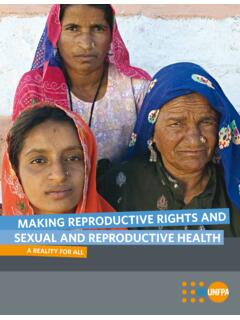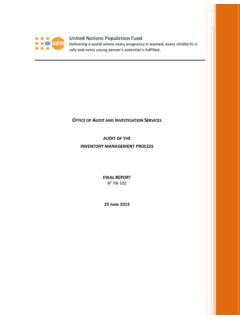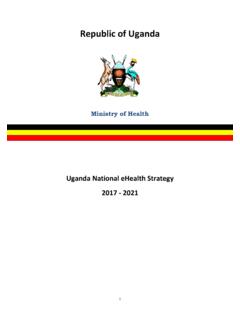Transcription of Uganda Case Study - UNFPA
1 1 EVALUATION OF UNFPA SUPPORT TO THE PREVENTION, RESPONSE TO AND ELIMINATION OF GENDER-BASED VIOLENCE AND HARMFUL PRACTICES 2012-2017 Uganda Case Study Evaluation Office, UNFPA January, 2018 1 Evaluation of UNFPA support to the prevention, response to and elimination of gender-based violence, and harmful practices Copyright UNFPA 2018, all rights reserved. The analysis and statements of this report do not necessarily reflect the views of the United Nations Population Fund. This is an independent publication by the Independent Evaluation Office of UNFPA . Any inquiries about this evaluation should be addressed to: Evaluation Office, United Nations Population Fund, e-mail: Information on the evaluation deliverables can be accessed at: Alexandra Chambel Evaluation manager, Chair of the Evaluation Reference Group Evaluation Office Itad & ImpactReady Evaluation Team Joseph Barnes Team leader Corinne Whitaker Gender equality and gender-based violence expert 2 submitted by Itad in association with Table of contents Acronyms and Abbreviations 3 1.
2 Context and background 6 National context 6 UNFPA response, including GBV and harmful practices interventions 12 The 8th UNFPA Country Programme 12 Programme Intervention Area 1: Laws, policies, and regulations 16 Programme Intervention Area 2: Health Sector response to GBV 17 Programme Intervention Area 3: Intersectoral response to GBV 17 Programme Intervention Area 4: The Joint Programme on Gender Equality - an intersectoral response to GBV 21 Programme Intervention Area 5: Humanitarian response 22 Programme Intervention Area 6: FGM, child and early marriage and work with youth 24 Programme Intervention Area 7: Fostering social norm change and working with men and boys for gender justice 26 Programme Intervention Area 8: CEDAW and Universal Periodic Review 27 Programme Intervention Area 9: Regional and global level advocacy 28 2. Methods 29 3. Findings 30 EQ1 Stakeholder priorities and human rights based approach 30 EQ2 Most relevant interventions 37 EQ3 UNFPA leadership and structures 43 EQ4 Strategic partnerships 48 EQ5 Contribution to outputs 52 EQ6 Contribution to outcomes 59 EQ7 Sustainability 64 4.
3 Considerations for the overarching thematic evaluation 69 Annexes 73 A: Reference Group 73 B: People interviewed 74 C: Documents reviewed 77 3 Acronyms and Abbreviations ACCS Advisory Consortium on Conflict Sensitivity AOR Area of Responsibility AWP Annual Work Plan CEDAW Convention on the Elimination of All Forms of Discrimination against Women CM Child Marriage CMR Clinical Management of Rape CPD Country Programme Document CORT Collaborative Outcomes Reporting Technique CO Country Office CRRF Comprehensive Refugee Response Framework CSO Civil Society Organisation DaO Delivering as One DCDO District Community Development Officer DFID Department for International Development DEVAW Declaration on the Elimination of Violence Against Women DLG District Local Government DV Domestic Violence ECP Emergency Contraceptive Pill FAO United Nations Food and Agriculture Organization FBO Faith-Based Organisation FGM Female Genital Mutilation FIDA International Federation of Women Lawyers GBV Gender-based Violence GBViE GBV in Emergencies
4 GDP Gross Domestic Product 4 GE Gender Equality GEEW Gender Equality and Empowerment of Women GoU Government of Uganda HC1 Health Center Level 1 HP Harmful Practices HRBA Human Rights-Based Approach IASC Interagency Standing Committee ICGLR International Conference on the Great Lakes Region ICPD International Conference on Population and Development IDPs Internally Displaced Persons INGO International Non-Governmental Organisation IP Implementing Partner JLOS Justice Law and Order Sector JPFGM UNFPA -UNICEF Joint Programme Female Genital Mutilation (FGM): Accelerating Change JPGBV Joint Programme on Gender-Based Violence JPGE UN Joint Programme on Gender Equality KAP Knowledge Attitudes Practice MAGs Male Action Groups MGLSD Ministry of Gender, Labour and Social Development MISP Minimum Initial Service Package MOH Ministry of Health MOS Ministry of Sports and Youth MOU Memorandum of Understanding MSR Multi-Sector Response NDP National Development Plan NPEGBV National Policy for Elimination of Gender-Based Violence NAPEGBV National Action Plan for Elimination of Gender-Based Violence 5 NGO Non-Governmental Organisation OHCHR Office of the High Commissioner for Human Rights PEP Post-Exposure Prophylaxis PMNCH Partnership for Maternal, Newborn, and Child Health PRDP Peace.
5 Recovery and Development Plan for Northern Uganda ReHOPE Refugee and Host Population Empowerment RH Reproductive Health SDG Sustainable Development Goal SGBV Sexual and Gender-Based Violence SOP Standard Operating Procedure SRH Sexual and Reproductive Health ToC Theory of Change TOR Terms of Reference UBOS Uganda Bureau of Statistics UDHS Uganda Demographic Household Survey UGX Ugandan Shilling UNCT United Nations Country Team UNDAF United Nations Development Action Framework UNFPA United National Population Fund UNHS Uganda National Household Survey UPR Universal Periodic Review UNSCR United Nations Security Council Resolution VAW(G) Violence Against Women (and Girls) 6 1. Context and background National context Uganda Uganda s 1995 constitution and broader normative and policy frameworks reflect global standards, are strongly supportive of Gender Equality (GE) and, within recent policy documents, address gender-based violence (GBV) explicitly.
6 Uganda is a state party to nearly all international human rights conventions as well as relevant regional protocols. Uganda was active in the post 2015 development process; it was one of first countries to integrate the principles and goals of the Sustainable Development Goals (SDGs) into its National Development Plan (NDP) even before the global documents had been finalized. Both GE and GBV are featured in Uganda s second NDP and evident in diverse sectoral plans. The National Health Sector Plan reflects a rights-based approach and acknowledges international conventions. The National Action Plan on Elimination of Gender Based Violence in Uganda (2016-2020) frames the issue of GBV as an urgent development priority and factor to address in achieving Uganda s development goals for 2020. Similarly, the interconnected work on ending child marriage and teenage pregnancy is framed by the new dialogue on leveraging for development the demographic dividend of a large, youthful population.
7 Uganda is rich in natural resources but marked since independence by a series of internal conflicts which have only recently abated. Although there are dramatic regional differences in socio-economic development, public sector investment, access to services, and health, education and rights indicators within Uganda1, the country has reported a consistent average annual economic growth rate of since 2002. The 2016 2020 United Nations Development Action Framework (UNDAF) noted that the country has built sufficient momentum for take-off . Despite the strong normative framework on GE, including regulations, guidelines, protocols and even district level laws and ordinances, actual implementation of the policies has been challenging. For women and girls, there has been mixed progress. education is one of the positive indicators with net enrollment for girls higher than for boys at both primary (80% to 79%) and secondary (29% to 27%) levels: the pattern at primary level holds in both urban and rural areas, although it varies significantly by region.
8 Although overall literacy rates for females over 10 years of age remain below males (70% compared to 78%), a six % point increase in the female rate since 2012 contributed significantly to a 4% increase in the national literacy Despite this progress, the maternal mortality ratio remains high at 438 per 100,000 live births. Maternal deaths account for 18% of all female deaths and girls age 15-24 account for up to 28% of maternal deaths. Uganda has one of the highest rates of teenage pregnancy in sub-Saharan Africa : 24% of girls aged 15 to 19 overall, with the majority of pregnancies taking place within marriage reflecting a high level of child marriage (49% by their 18th birthday). Complications of pregnancy and childbirth are the leading cause of disability and death among female adolescents in 1 In Karamoja region, an estimated % of the population live below the poverty line.
9 Food insecurity stood at 56 % in 2014, with % of children in Karamoja exhibiting significant stunting due to insufficient food. 2 Uganda National Household Survey, 2016/2017 3 Ibid., 2011; Better Life for Girls Project Summary, 7 Politically, women do wield some influence: women account for 35% of parliamentarians (2016) and 44% of local council members (2013). Indeed, the First Lady s office has been instrumental in advancing work on GBV. Yet only one third of women are owners or co-owners of land. Uganda is surrounded on three sides by countries in active conflict and this has resulted in cyclic waves of refugees, most of whom remain in settlements in the border districts. Uganda has a progressive refugee hosting policy, which is acknowledged in the international community. The country was the test case for the first Solidarity Summit of international development partners, a coordinated global initiative to support Uganda and its partners in addressing the needs of 1,355,764 refugees, including 1,021,903 from South Sudan.
10 The second largest population from the Democratic Republic of Congo includes settlements of refugees, many of whom have been in Uganda for several years. Despite substantial investments, the pace of the influx has strained services originally established for half the current population: in one week in May of 2017, an average of 1,746 refugees arrived daily with a total of 12,221 for the week. There are common features to many of the refugee situations in the region, including the experience of sexual violence, a fact acknowledged in multiple declarations of the International Conference on the Great Lakes Region (ICGLR) since 2011 and the basis for the 2008 Goma Declaration on Eradicating Sexual Violence and Ending Impunity in the Great Lakes Region (The Goma Declaration). Uganda has been an active participant in joint action within the region which has also informed a global dialogue, particularly on the issue of post-conflict response to GBV.












